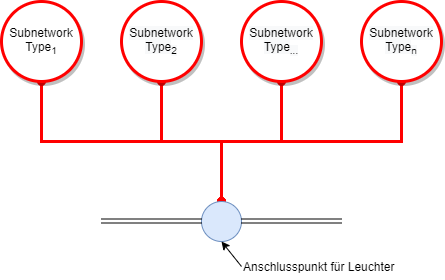General
A subnetwork controller can only form and control a single subnetwork (service territory)!
The configuration of subnetwork controllers is complex and demanding. For this reason, the definition and introduction of subnetwork controllers should be handled with caution. Experience shows that many questions can be answered without a subnetwork controller. If it should be necessary to have several subnetwork controllers for different issues, the "candelabra principle" can be used as an alternative. This is used to create additional networks, which can usually be described as virtual (not physical) networks. An example of this can be the area subdivision for organizational units (for example, master districts). These are also much easier to map via queries or the capture of areas.
Candelabra principle
This method is used to insert subnetwork controllers that are to be designated as virtual. These have no effect on the media and its behavior. They only serve to answer further questions. In practice, there are various possible applications for this. This principle should only be applied when it is really necessary. Many questions can also be answered via network queries and do not require the creation of independent subnet lines. One such example is the shut-off valve for industrial connections. This can be answered by reversing the question. At the transfer point the query is started which gate valve is the first that can be reached from this point (if necessary, other criteria can also be used for the query). It is also conceivable that the gate valve is provided with an attribute to identify it.
Examples |
Description |
|---|---|
Isolation zones |
This is about the formation of zones, which are considered as a separate entity. For this purpose, gate valves are required in the network, which have a network attribute for the boundary of the isolation zone, which uniquely identifies them as isolation gate valves. The network is extended up to such a gate valve or a regular subnetwork controller. The gate valve itself is not part of the isolation zone, but only limits it. The reason for this is that it separates two networks. Attention this example is not intended for pressure stages, as these are already formed in the water network by the subnetwork controllers and gate valves (further information on this can be found in the water). The only requirement is that the relevant gate valves separating the zones are closed. |
Master or maintenance circles |
Used to map responsibilities. In this case, too, an element including a network attribute must be provided to mark the subdivision of responsibilities. In this case, various additional points must be taken into account, such as the fact that the subdivision must not take place on but only between two lines. |
Many issues in networks form very static entities that are not frequently adjusted. For this reason, before the introduction of a virtual Subnetwork, the question must be asked whether this cannot be answered by a simple evaluation or a corresponding network tracing.

In principle, any number of additional controllers can be introduced using this method. It should be noted, however, that it is not wise to do this extensively. On the one hand, the configuration effort as well as the specifications and expenses for data acquisition and maintenance increase considerably. The connection point (blue) of the candelabra (red) is preferably to be chosen inside the station in the area of the plant construction and must only comply with the rules for edge-edge or edge-junction. Of course, it is conceivable that such elements could also be placed in the network (line construction), but this would make maintenance and servicing massively more complex and thus more prone to error. For this reason, it is not advisable, as the structure becomes very confusing and leads to questions that can only be answered in the data. This means that the effort for analyses and the complexity increase considerably and can usually only be managed by experts.